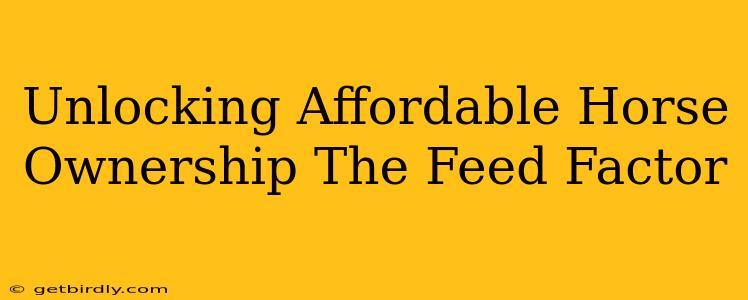Unlocking Affordable Horse Ownership: The Feed Factor
Owning a horse is a dream for many, but the costs can seem daunting. While veterinary care, farrier services, and boarding fees significantly impact the overall expense, the cost of feed is often the largest single expenditure. Understanding how to manage your horse's nutrition effectively is crucial to unlocking affordable horse ownership. This article will delve into strategies for reducing feed costs without compromising your horse's health and well-being.
How Much Does Horse Feed Really Cost?
The cost of horse feed varies dramatically depending on factors like location, the type of feed (hay, grain, supplements), the horse's individual needs, and the quality of the feed. A horse might consume anywhere from 15-25 pounds of hay daily, plus supplemental grain depending on workload and body condition. High-quality hay can cost anywhere from $5 to $20 per bale, while commercial grain can range from $20 to $40 per bag. These costs can quickly add up, easily exceeding several hundred dollars per month.
Strategies for Reducing Feed Costs
Fortunately, several strategies can significantly reduce your horse's feed bill without sacrificing their health.
1. Optimize Hay Consumption:
- High-Quality Hay is Key: Investing in high-quality hay, even if it's slightly more expensive, often means less overall consumption. A horse will feel fuller and more satisfied on nutrient-rich hay, reducing their need for expensive grain supplements. Consider having your hay tested to determine its nutrient content.
- Slow Feeders: Slow feeders encourage horses to eat more slowly and naturally, improving digestion and reducing the risk of colic. This can lead to better hay utilization and less wasted feed.
- Hay Storage: Proper hay storage is crucial. Protecting your hay from the elements prevents spoilage and reduces waste.
2. Strategic Grain Feeding:
- Assess Your Horse's Needs: Don't overfeed grain. Consult with a veterinarian or equine nutritionist to determine the appropriate amount of grain based on your horse's age, breed, activity level, and body condition. Overfeeding can lead to unnecessary costs and health problems.
- Consider Alternatives to Commercial Grain: Look into alternatives such as beet pulp, which is a highly digestible and cost-effective fiber source. It can be a good supplement to hay, especially for horses with lower body weight.
- Bulk Buying: Buying grain in bulk can often result in lower per-unit costs, but make sure you have adequate storage space to prevent spoilage.
3. Pasture Management:
- Maximize Pasture Usage: If possible, utilize pasture to reduce hay consumption. Proper pasture management, including rotational grazing and weed control, can maximize the nutritional value of your pasture and minimize the need for supplemental hay.
- Supplement with Forage: Even if your horse has access to pasture, you may still need to supplement with hay, especially during winter months when pasture growth is limited.
4. Utilizing Supplements Wisely:
- Targeted Supplementation: Only use supplements when truly necessary. Avoid giving unnecessary supplements that are not specifically recommended by your veterinarian or equine nutritionist.
- Read Labels Carefully: Pay close attention to the ingredients and nutritional value of supplements before purchasing them.
Frequently Asked Questions (PAA)
What type of hay is cheapest for horses?
The cheapest hay is usually grass hay, such as Timothy or Orchard grass. However, the nutritional value can vary, so it's important to ensure it meets your horse's needs. Cost also depends on location and availability.
How can I save money on horse feed without sacrificing quality?
The key is strategic planning and informed decision-making. This involves choosing high-quality hay, carefully assessing your horse's grain requirements, utilizing pasture efficiently, and using supplements only when absolutely necessary. Regular vet check-ups are crucial to monitor your horse’s health and adjust feeding as needed.
What are the best ways to prevent horse feed waste?
Utilize slow feeders, maintain proper hay storage, and only feed the appropriate amount of grain based on your horse's needs. Regularly monitor your horse’s hay and grain intake to catch potential problems early.
Conclusion
Managing your horse's feed effectively is a crucial aspect of responsible and affordable horse ownership. By implementing the strategies outlined above, you can significantly reduce your feed costs without compromising your horse's health and well-being. Remember to always consult with your veterinarian or equine nutritionist for personalized advice tailored to your horse's specific requirements. Through informed decisions and diligent management, you can enjoy the rewards of horse ownership without breaking the bank.

